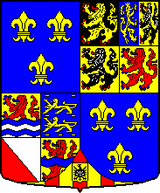- Dutch Republic Lion
-
The Dutch Republic Lion (also known as States Lion) was the badge of the Union of Utrecht, the Republic of the Seven United Netherlands and is a precursor of the current coat of arms of the Kingdom the Netherlands.
Contents
Origin
The new state of the Union of Utrecht created in 1579 during Eighty Years War had not its own badge initially. The first month the States General used the badge of the Brabant because Brabant was the leading region in the Habsburg Netherlands,since it was the most populous one, it was in the center, the seat of government was established there, in Brussels, and economically it was the most prosperous province. But the Duke of Parma and the Spanish General Alexander Farnese, began in 1579 a campaign against the rebellious provinces known as (Parma's Nine Years) and while capturing rapidly several cities of Brabant ('s-Hertogenbosch on July 1, 1579, see Schermer Riot) and Leuven and Diest were already in Spanish hands, Antwerp was still the head of the Dutch Revolt. But this chaos made Brabant to lose its hegemony in the Netherlands, and it was switched over to another weapon, Dutch Republic Lion .
New States Lion
In 1574 a new heraldic motive was chosen, which had to include the Dutch Lion, a widely recognized and respected heraldic motive in the Netherlands. This new Dutch Republic Lion should represent every region and not one in particular.
The chosen design was a gold lion on a red field. Its symbolism meant a blend of the coat of arms of the provinces of Brabant, Gelderland (from these two the golden lion was taken) and Holland (whose coat of arms was the opposite) and those of Burgundy and Nassau.
The Dutch Republic Lion had also a sheaf of arrows and a sword bar, taken from the crest of Charles V in his seal as "Lord of the Netherlands" and the sheaf of arrows as a symbol of unity. Their sovereignty emphasized the "Mightiness lords" of the States General by a crown to place their arms.
The number of arrows changed, at first there were 17, despite the fact that the Union of Utrecht counted 11 districts after the Fall of Antwerp in 1585, so it eventually changed to 11, but with the Reduction of Groningen 7, the number of arrows on the arms fixed at 7 in 1606, but the seal stiill remained with 17 arrows until 1795.
Duke of Anjou
In 1581 the Union of Utrecht declared themselves independent from Spain by the Edict of Verlatinghe. At that time the States-General considers that the rebellious Dutch had to be a kingdom, and therefore had to look for a new ruler. The Duke of Anjou was asked above, what they accept. He replaced the Generality Lion by a badge that he himself put together all the badges of the, at that time, nine Dutch rebellious provinces with his own: Right corner, clockwise:
- Gelderland;
- Holland;
- Flanders;
- Brabant;
Left corner, clockwise:
- Friesland;
- Overijssel;
- Utrecht;
- Zealand;
Bottom:
- Mechelen;
and twice the French lilies left and right. But the Duke of Anjou was not a good leader and they did not want to give too much power, then he tried to respond but by seizing by force and establishing the French fury, but he was eventually expelled. After that the States-General re-established the previous badge.
Batavian Republic
The Batavian Republic was founded in 1795 used in its first year the arms of the Republic of the Seven United Provinces, the Dutch lion or lion with crown generality, sheaf of arrows and swords. But on May 4, 1796 the Dutch Lion badge was replaced by a free drawing of the Netherlands Maiden around an altar with an anchor dismantled, but it was decided to keep States Lion with HER.
Batavian Commonwealth
The substitution in 1801 of the Batavian Republic by the Batavian Commonwealth also had its impact on heraldry. On April 12, 1802 it was decided that the new badge of the Commonwealth would be a golden lion on a red field again. The number of arrows that bears the lion in the leg was not established.
Kingdom of the Netherlands
A modified version wearing a King's Crown was stablished in February 1814 for a further 22 months as the badge of Willem Frederik, Sovereign Prince of the Netherlands. This badge was replaced by the National Coat of Arms of the Netherlands, which is based in the Dutch Republic Lion .
Links
Categories:- Badges
- Dutch coats of arms
- Dutch monarchy
- Dutch Republic
- Heraldry
- History of the Netherlands
- National coats of arms
- National symbols of the Netherlands
Wikimedia Foundation. 2010.




